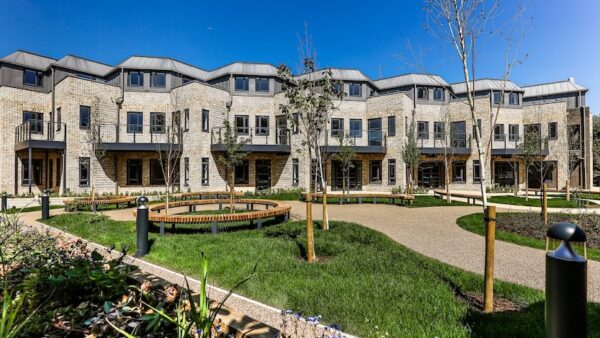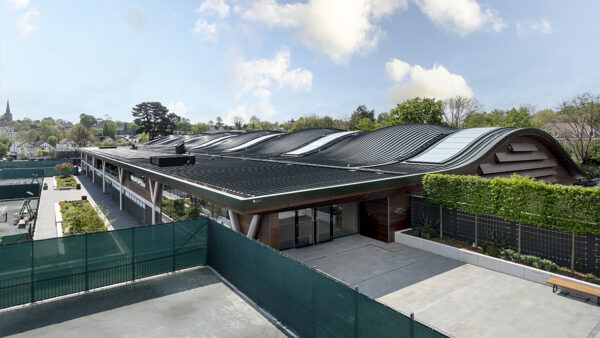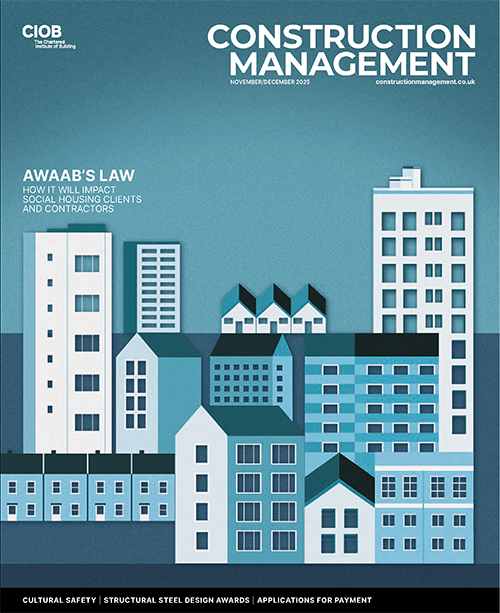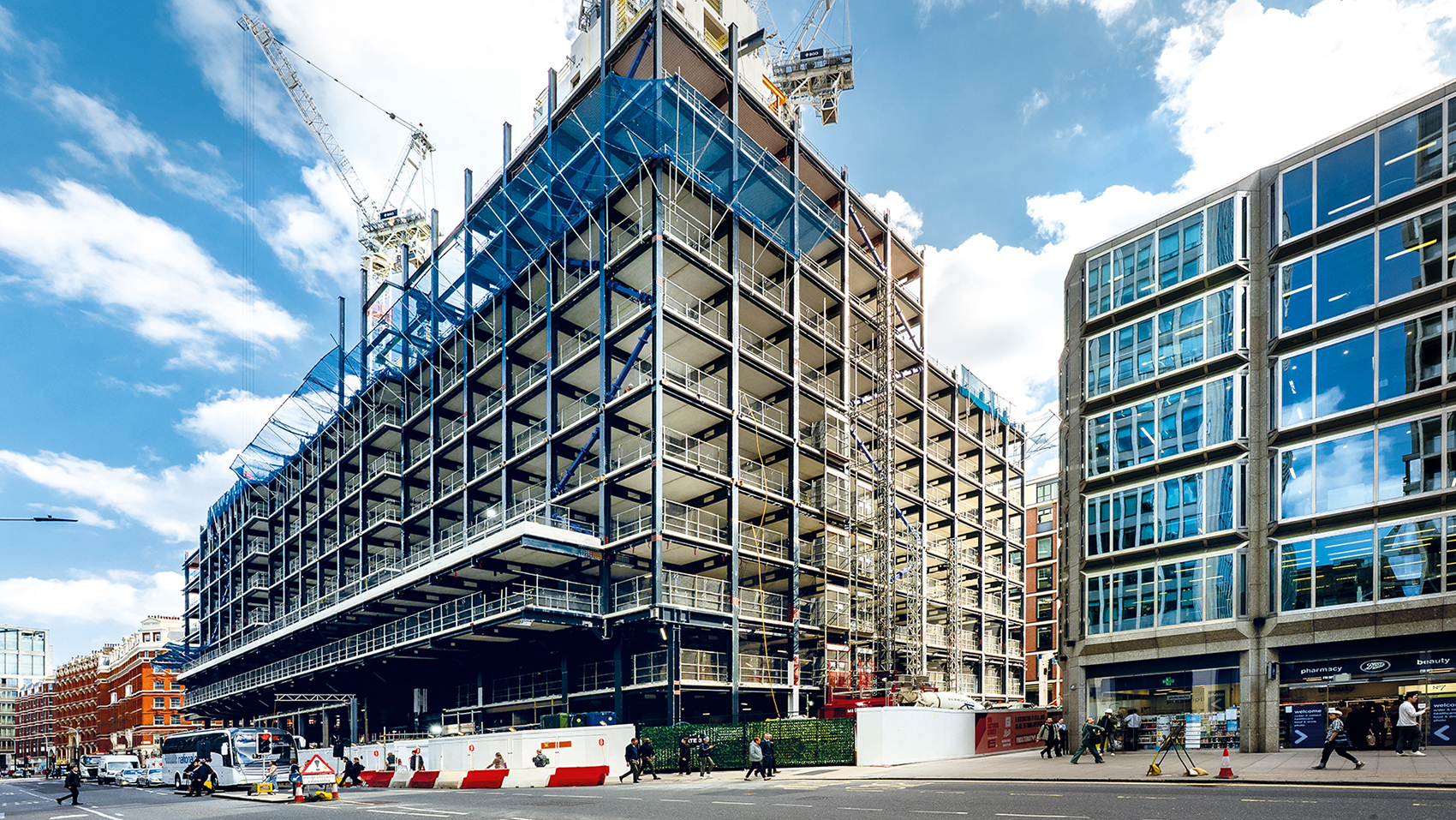
Minimising the carbon footprint on BGO’s 105 Victoria Street retrofit scheme in Westminster has pushed Skanska’s supply chain further than before. Kristina Smith visited the site.
Counting carbon is important at 105 Victoria Street in Westminster. Developer BentallGreenOak (BGO) and contractor Skanska are trimming all the emissions they can to cut carbon associated with the construction of the building and its operation.
The office building, which is 470,000 sq ft (43,660 sq m), has 15 office floors, retail at ground level and a two-storey basement. It replaces a 1970s-built House of Fraser store, which also had offices in its upper floors. The most carbon-friendly solution could have been to retain and refurbish the existing building, but attracting tenants would have been difficult, explains Emma Foster, principal at BGO.
Project: 105 Victoria Street, London
Client: BentallGreenOak (BGO) on behalf of the Welput Fund, a specialist central London office fund managed by BGO
Architect: Kohn Pedersen Fox Associates in partnership with Henning Larsen Architects and Adamson Associates Architects
Contractor: Skanska
Structural engineer: AKT II
Sustainability consultant: Sweco
Specialist contractors
Demolition and piling: Erith (Expanded Piling subcontracted to Erith)
Concrete substructure and superstructure: Careys
Concrete supply: London Concrete
Steel frame and installation of precast floor planks: Severfield
Manufacture of concrete floor planks: Explore Manufacturing (Laing O’ Rourke)
Cladding: Permasteelisa Group
Blockwork: Lesterose
Steel spiral stairs: Patera Engineering
“The existing building had low floor-to-ceiling heights, and the column structure was very crowded. There were a lot of parts that were not fit for a modern office building,” says Foster. “For retention of staff, you need good buildings, with good wellness credentials.”
BGO has calculated that by using low-carbon materials and methods in construction and 100% renewable electricity in operation, the difference in embodied carbon between the new-build option and the refurb one will be wiped out in just six years. To do that, Skanska is pushing its supply chain further than before, looking at new materials and methods and demanding rigorous carbon counting.
For Skanska engineering manager Ben Ford, this has meant a deep dive into materials science, alternative fuels and carbon accounting. “When you are working to industry-leading sustainability targets, there are a lot of unforeseen challenges with using low carbon materials and incorporating them into the design,” he says.
Once 105 Victoria Street is occupied next year, it should be bristling with sustainability and wellbeing certifications: BREEAM Outstanding, Energy Performance Certification (EPC) A, Nabers 5.5 star and WELL Platinum.
Climbing high
BGO appointed Skanska under a pre-construction services agreement (PCSA) in 2020 when
the design of the building was at RIBA Stage 2. Once BGO gained vacant possession of the old building, Erith moved in to do the strip-out and demolition, with Skanska starting on site in August 2023 when piling began – at which point Erith was novated over.
In January 2024, Careys began the substructure and superstructure concrete works, completing the 6,350 sq metre concrete raft in May 2024, with the building’s two cores reaching their full height in December 2024. Severfield, which is erecting the steel frame and precast concrete flooring planks, started in September 2024, with topping out due in September this year.
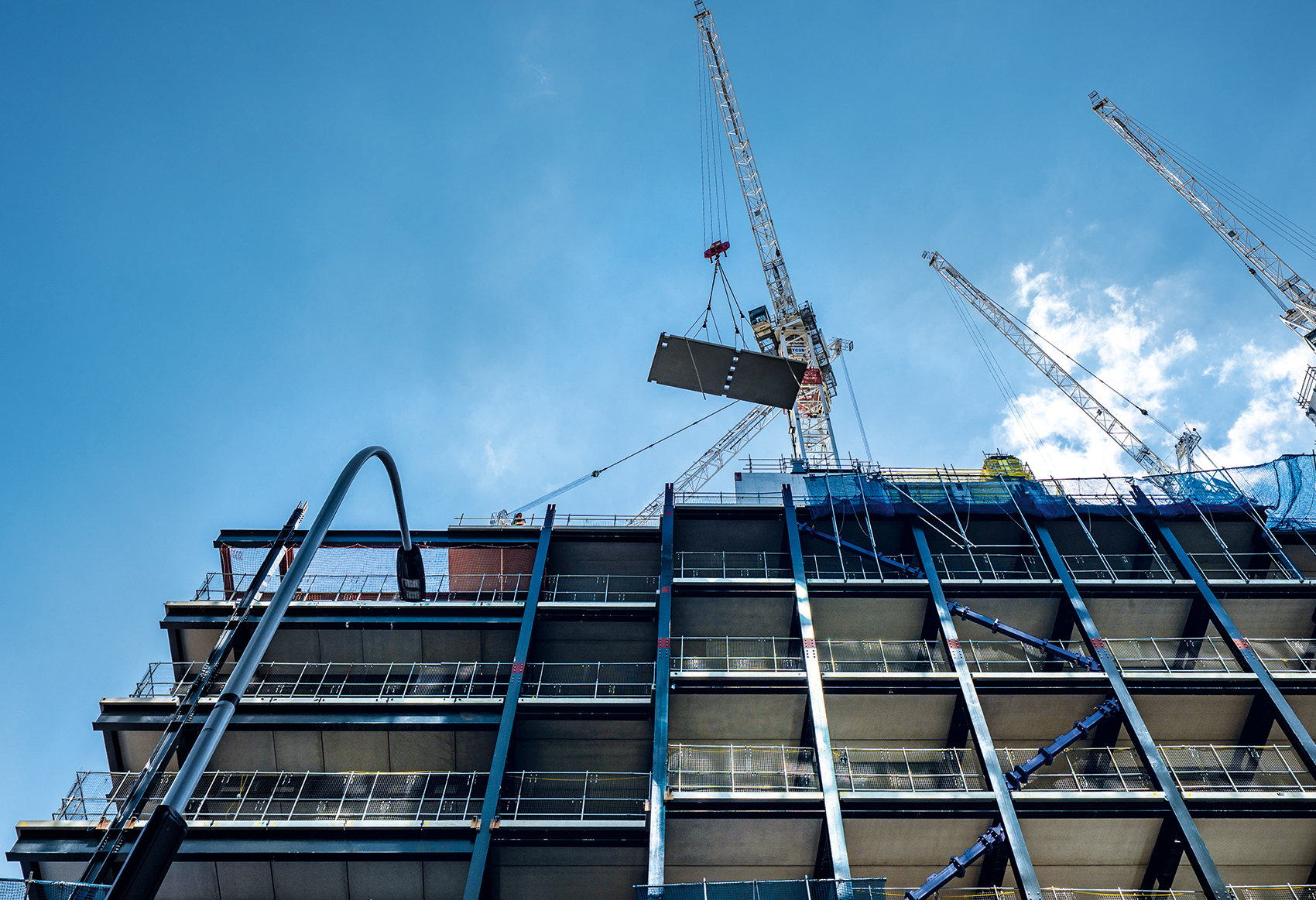
By the end of April 2025, the steel frame was at level 11, where the building starts to step in to make space for the first of 30,000 sq ft (2,790 sq m) of green terraces, with a walking track on this level for tenants who prefer active meetings. Down at level one, Permasteelisa was installing the cladding, which will be a mixture of aluminium and terracotta panels, designed to echo surrounding buildings.
As well as looking for supply chain partners that would come up with ways to cut carbon, Skanska and BGO wanted companies that would bring ideas for improving efficiency and safety. “When we did the procurement, especially for packages such as steel, concrete, lift and facade – we went for a technical tender first. They are scored technically and then they return a cost,” says Foster. “I don’t think Skanska had done that before.”
This approach has led to a raft of carbon-saving ideas being trialled or deployed. Some of these could be considered industry best practice, others are pushing best practice forward and a few are new to the industry.
Sustainable plant and trucks
Erith’s whole fleet of plant and the trucks taking demolition materials offsite ran on HVO. “That’s a real step change in how they deliver work,” says Foster. Meanwhile, Severfield trialled HVO for delivery of steelwork and Careys trialled an electric concrete truck.
Carbon savings were made in the basement for both permanent and temporary works. Skanska was able to modify the design to partially use some of the existing basement wall, reducing the thickness of the new internal concrete wall – and hence reducing associated carbon emissions.
Careys modified the propping design for the basement so that one layer of props rather than two was needed. Then, in a novel move, those props were sent off to Celsa’s electric arc furnace (EAF) in Cardiff to be turned into rebar for the project. “That’s a genuine circular economy process,” says Ford.
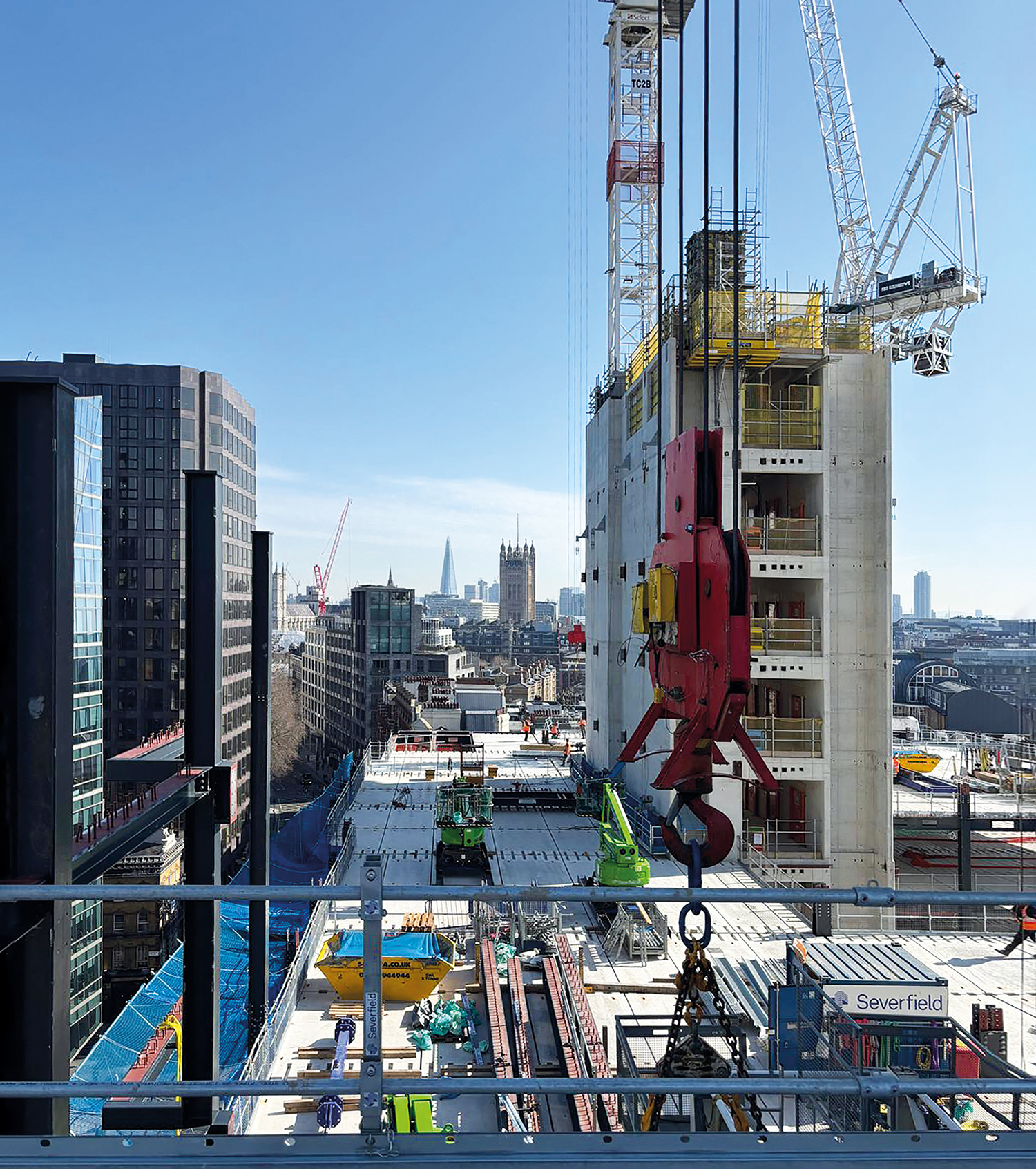
Skanska worked with Severfield and structural engineer AKT II to optimise the use of steel members made from XCarb – made in an EAF using large proportions of recycled steel.
There are some tensions between cutting carbon and designing for circularity, explains Ford. Using standard section sizes is desirable when considering disassembly and reuse at end of life, but that can mean heavier sections have to be used.
Severfield also created a reusable and modular temporary brace. “Rather than just welding or bolting on a section and chopping it out at the end, we can now use this,” says Ford. “It’s a really simple thing… now they will develop this and use it for temporary works on other projects.”
Concrete plans
Concrete has come under close scrutiny on this project too. Severfield’s contract includes the installation of 3,000 large precast concrete floor planks, typically 9m by 2.25m and 175mm deep. With one layer of reinforcement and 50% ground granulated blast furnace slag (GGBS) to replace cement, they don’t require any in-situ concrete to be poured on top of them, as an Omnia plank-type arrangement would do.
The underside of the planks will be left exposed, enabling night-time cooling using natural ventilation, which in turn will reduce energy expended on air conditioning.
Finding the right concrete mix, which gave a good finish on the underside of the planks, required trials with different accelerators and curing agents. The planks are also designed to run right to the edge of the building, which meant that fixings for the facade had to be designed into them.
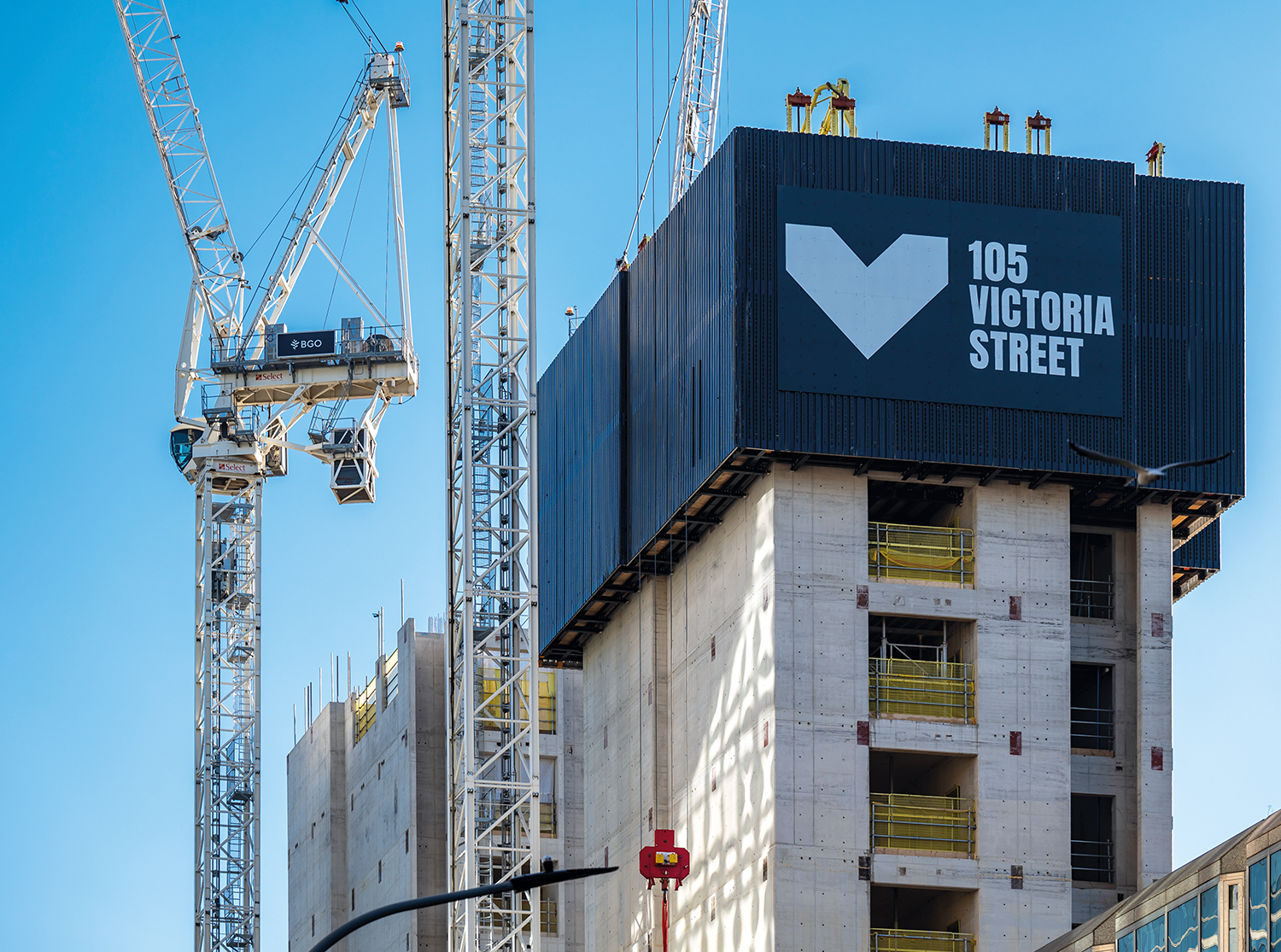
“You would not normally take the planks up to the perimeter or, if you did, you would have a wet topping that the fixings would go into,” explains Ford. “Here, there is no wet topping, so we had to get everything right and allow additional time for design.”
The jump-formed cores contain 70% GGBS, and required six months of trials with Careys and supplier London Concrete to get the mix design right. Thermocouples in every pour measure the heat – which can be converted to strength – so that the formwork is never moved too soon.
“We achieved cycle times of around one week per floor, which is standard, but we have big cores here, particularly the west one,” says Ford.
BGO and Skanska would have liked to go even further with the concrete. Ford spent almost two years researching cement-free concrete and overseeing trials.
“We really tried to make it work but it came down to reliability and cost,” says Foster. “We were prepared to pay more but the cost was not justified. It had really good carbon savings but not for the millions it would cost.”
Lack of insurance
Another issue that made cement-free concrete unviable is insurance – or lack of it. “The insurance market was not on board with it,” says Foster. “And that wasn’t just the CAR [contractors’ all risk] policy, it was also the building policy post completion.”
There were materials where BGO did feel additional cost was justified. For instance, recycled raised access flooring tiles cost more than new ones – but the carbon savings justified the additional spend, says Foster. These had to be sourced 18 months early, since they would not have been available in the quantity needed at short notice.
Predicted and then actual carbon emissions have been recorded through every stage of this project, with the help of specialist consultant Sweco. As the project has advanced, it has been challenging to get specific – rather than generic – carbon footprints for some of the products and materials, says Ford.

CV: Ben Ford, engineering manager, Skanska
With a maths teacher for a mum and a QS for a brother, construction seemed a good fit for Ben Ford. A work placement with John Sisk confirmed this proposition. “I thought ‘this is the perfect combination of everything I want to do’,” he says.
Sponsored by Costain through a master’s degree in civil engineering at the University of Exeter, Ford worked initially on civil engineering jobs including Crossrail contract C405 at Paddington and London Bridge Station redevelopment.
A high-rise project near his home in Woking tempted him to move from civils to building with Sir Robert McAlpine before the opportunity to work on 105 Victoria Street brought him to Skanska in August 2021.
A chartered member of the Institute of Civil Engineers (ICE), Ford says he benefited hugely from a placement at Ramboll, which gave him an understanding of the design process, which is vital for his current role.
His advice to those starting their careers is this: “Never be afraid to ask questions.”
Image: Adam Husz
“The bit we struggle with is EPDs [environmental product declarations]. That has proved really difficult,” says Ford. “Because we are in [RIBA] Stage 5, it has to be project specific.”
For suppliers such as Severfield, counting carbon to this degree of accuracy is business as usual. But for smaller companies this isn’t the case, and the challenge is exacerbated by the fact that many of them are sourcing components from multiple suppliers.
“It’s about educating people about what an EPD is. It can make quite a big difference,” says Ford. This has proved to be the case for the mechanical, electrical and plumbing (MEP) elements of the project, a significant contributor to the carbon footprint, where the actual emissions have come out lower than initial estimates.
New village for Victoria
The site of 105 Victoria Street, between Victoria Street and Howick Place, is very close to the location of Palmer’s Village, which was demolished in the 1840. Set up in the 17th century by one Reverend James Palmer, it had a school, almshouses, chapel, inn and village green.
With a nod to this, BGO is styling its ground floor, which will be open to the public, as a village square. Commuters, locals and tourists will be able to wander through, via wide openings with guillotine doors, partaking in shops, cafes and the odd performance.
An already eye-catching feature of the ground floor is a spiralling ramp, soon to have a spiral metal staircase at its centre, which will take cyclists and pedestrians down to the basement level where there will be cycle parking, a gym, changing rooms and a bicycle repair shop.
There’s also an events area in the basement, which will double as a sports court, with LED markings that can change to match the sport. BGO is planning an inaugural baseball match for local school children to mark the topping out later in the year and the school will go on to use the court throughout the building’s life. Primary school kids will be visiting too, helping to grow vegetables in an ‘urban farm’ – big planters – on the upper terraces.
All this attention to sustainability, community, green spaces and wellness should make the planners happy. But will it attract tenants to 105 Victoria Street, which is a speculative development? It seems that it will. In September 2024, BGO announced a prelet deal for 135,000 sq ft (12,540 sq metres) over four floors with Evercore Investment Bank, which will relocate from Mayfair. This was the biggest such deal that Victoria has seen.




